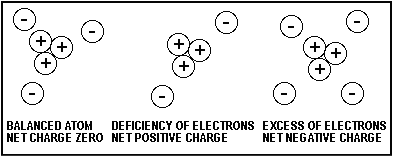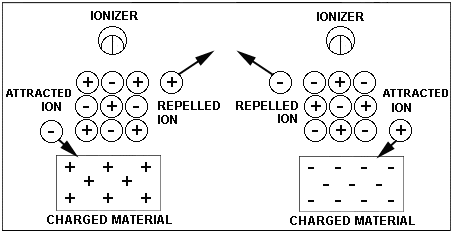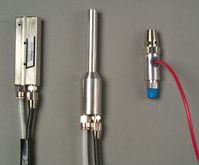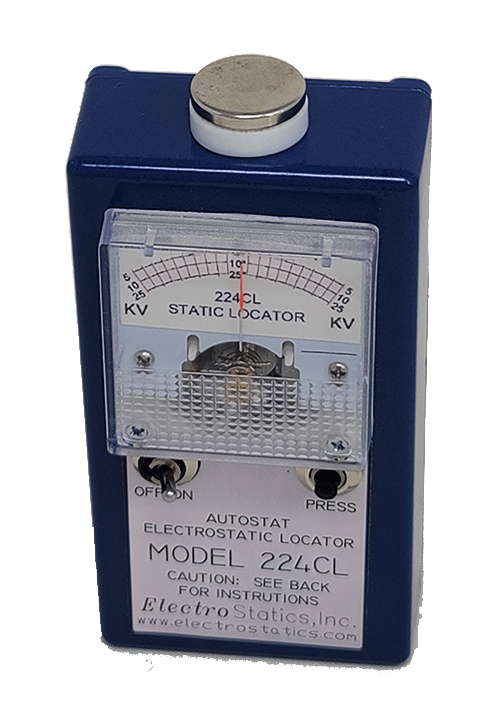Static Electricity and Static Control removal: Technical Overview and Ionization Systems
Static electricity control is essential in modern manufacturing, electronics, and packaging industries where electrostatic charge can cause ESD damage, dust attraction, or process interruptions. Understanding how static electricity is generated—and how to neutralize it—is key to maintaining product quality and safety. Using ionization systems, anti-static bars, and grounding equipment, static charge can be effectively eliminated from non-conductive materials such as plastic, paper, and glass. Electrostatics.com provides advanced industrial static control solutions designed to measure, neutralize, and prevent electrostatic discharge across a wide range of applications. Whether you need ESD protection for electronics assembly or static eliminators for converting lines, ionization offers the most reliable method to restore balance and improve process efficiency.Technical Overview of Electrostatic Phenomena, ESD Protection, and Ionization Systems for Industrial application needing to control Static Electricity to add or remove reduce or eliminate
Introduction to Static electricty:
This article provides a detailed technical explanation of static electricity and proven methods to measure, neutralize, and eliminate electrostatic charge in industrial and electronic environments. It addresses key engineering and process-control questions such as:
What is static electricity and how is it generated?
How does electrostatic discharge (ESD) damage components and materials?
What causes charge buildup on plastics, paper, and glass and like materials?
How can static electricity be neutralized using industrial ionizers and anti-static equipment?
What best practices ensure effective static control in manufacturing processes?
Understanding the causes and control of static charge is essential for improving product quality, reducing downtime, and preventing ESD-related failures.
What Is Static Electricity?
Static electricity (also called electrostatic charge) is an imbalance of electric charge on the surface or within a material. Unlike current electricity, which involves continuous electron flow through a conductor, static electricity represents electricity at rest.

Charge generation commonly occurs through:
Triboelectric charging – contact and separation between dissimilar materials
Induction – charge redistribution due to nearby electric fields
Conduction – direct charge transfer between conductive surfaces
The polarity and magnitude of static charge depend on material composition, surface resistivity, humidity, and environmental conditions. When the electrostatic potential difference between objects exceeds the dielectric strength of air, a static discharge occurs — known as electrostatic discharge (ESD).
Example: Atmospheric Electrostatics and Lightning
A large-scale example of static electricity is lightning. In the atmosphere, static charge builds within clouds due to particle collisions and friction. When the electric field strength exceeds approximately 3 megavolts per meter, air — normally an insulator — breaks down, resulting in a high-current discharge.
This process demonstrates how static electricity transitions into dynamic electricity to neutralize charge imbalance. On a smaller scale, similar discharges occur when you touch a door knob and feel a shock. It also happens in industrial and electronic systems, where uncontrolled static buildup can cause costly ESD damage, attract contamination, cause operator shocks.
Industrial Impact of Static Electricity
Uncontrolled static electricity can create significant problems in industrial environments, including:
Electrostatic discharge (ESD) damage to sensitive electronic components
Dust and particle attraction, causing contamination on film, plastic, and paper webs
Process interruptions due to static adhesion, misfeeds, or jams
Ignition hazards in environments with flammable vapors or powders
Operator shock safety and productivity issues for the workforce
The financial impact of static-related issues is measured in billions of dollars annually across industries such as electronics manufacturing, medical device manufacturing packaging, converting, plastic manufacturing, and printing.
How to control or remove static electricty and Neutralization Methods
Effective static control systems combine both charge prevention and active neutralization strategies. Common methods include:
Grounding and Bonding:
Provides a conductive path to safely dissipate electrostatic charge from equipment and personnel. This method is effective with conductive materials.Environmental Control:
Maintaining proper humidity levels increases surface conductivity and reduces charge accumulation. This is an expensive way to reduce static electricity and can lead to heath concern with mold and mildew.Ionization Systems:
Industrial ionizers (also called static eliminators or anti-static ionizers static bars anti static blowers) produce balanced streams of positive and negative ions that neutralize static charges on insulating materials such as plastic, glass, and paper.
Types include AC corona ionizers, DC ionizers, pulsed DC ionizers, and plasma ionizers. Of these methods AC corona ionizers, DC ionizers are the most reliable and cost effective.
These systems are essential in clean rooms, converting lines, medical device manufacturing and packaging, printing, circuit board manufacturing, packaging areas, and ESD-safe environments.

- Anti-Static Materials and Coatings:
Incorporating conductive fillers, carbon loading, or surface treatments helps reduce triboelectric charging. This coating or material change can be expensive and may not be possible depending on the end use such as material used in a medical device.
- Measurement and Monitoring:
Electrostatic field meters, charge plate monitors, and ion balance testers provide quantitative data for process verification and equipment calibration.Applications of Static Control and Ionization Equipment
Static control solutions are critical in many industries, including:
Electronics assembly and semiconductor manufacturing (ESD protection)
Plastic film extrusion, bagging, and thermoforming (static neutralization)
Printing and converting (web cleaning and dust control)
Pharmaceutical and medical packaging (particle attraction prevention and removal)
Circuit board manufacturing cleaning layer of copper and dielectric
Powder coating and materials handling (ignition hazard reduction)
Using high-performance ionization equipment and anti-static bars ensures consistent static elimination and process reliability.
Conclusion
Understanding the science of static electricity and applying proper static control techniques are essential for modern manufacturing. By integrating ionization systems, grounding, and anti-static equipment, facilities can effectively neutralize static charge on insulating surfaces, protect sensitive electronics from ESD events, and maintain safer, cleaner, and more efficient operations.
Frequently Asked Questions (FAQ)
1. What causes static electricity in industrial environments?
Static electricity is typically generated through triboelectric charging, which occurs when two dissimilar materials contact and separate, causing electron transfer. In manufacturing, this happens with plastic films, paper webs, textiles, and conveyors. Low humidity, high-speed processes, and non-conductive materials increase charge accumulation, leading to electrostatic discharge (ESD) and contamination issues.
2. How do ionization systems eliminate static electricity?
Ionization systems (also called static eliminators or anti-static ionizers) produce balanced streams of positive and negative ions that neutralize surface charge on insulating materials. The ions recombine with charged areas, restoring electrical balance. Industrial ionizers include AC corona, DC, and pulsed DC ionizers, often used in packaging, converting, and electronics assembly environments.
3. What is the best way to remove static charge from plastic, paper, and glass?
To remove static charge from non-conductive materials such as plastic, paper, and glass, use industrial ionization equipment in combination with proper grounding and humidity control. Ionizers continuously neutralize charge buildup, while grounding systems dissipate charge safely from conductive machinery and personnel. This integrated approach ensures consistent static control and ESD protection.
4. How does static electricity cause electrostatic discharge (ESD)?
Electrostatic discharge (ESD) occurs when a charged object contacts or comes close to another object with a different potential, allowing electrons to flow rapidly and equalize the imbalance. Even low-level discharges can damage semiconductors, sensors, and printed circuit boards, making ESD control systems essential in electronics manufacturing and cleanrooms.
5. What are the most effective static control products for industrial applications?
Effective static control products include:
Ionization bars and blowers – neutralize static on moving materials
Grounding and bonding systems – provide discharge paths for conductive objects
Anti-static films and coatings – minimize charge buildup on surfaces
Electrostatic field meters – measure charge levels for process monitoring
Combining these technologies ensures reliable static elimination and enhanced process efficiency.
How to remove static electricity?
Active Solutions to Reduce or
Eliminate Static ElectricityHow does anti static ionizing equipment work?
By following the above steps, you can reduce the hazards of building up high charges of static electricity to a point. However the above steps are passive and of limited effectiveness. Also changing a specified material or adding a spray may not be possible or allowed. An active method static control is by ionization. It is important to understand that static electricity cannot be entirely eliminated. In fact, the terminology, "static eliminators," is definitely misleading.
Static eliminators are really ionizing units that produce both positive and negative ions to be attracted by the unbalanced material so that neutralization does occur. For example, a charged piece of material can be neutralized by utilizing a static neutralizer. However, it does not eliminate the static electricity because, if the material is again fractioned after being neutralized, static electricity will be generated.
In order to gain the most benefit from your static neutralizing or static control equipment, it is important that you understand how they operate and how they provide the means of neutralization. Most electronic static neutralizers are constructed by placing a high voltage on a sharp point in close proximity to a grounded shield or casing. There are two basic types static control ionizers- AC & DC.
With Alternating Current ionizers the high voltage alternates current pulses through the 60 cycle operation, the air between the sharp points and the grounded casing is actually broken down by ionization and therefore both positive and negative ions are being generated. Half of the cycle is utilized to generate negative ions and the other half is utilized to generate positive ions. On 50 or 60 cycles per second power grid polarity is changing ionization every 1/100 or 1/120 of a second.
DC ionizers also put a high voltage on a sharp point but need to produce the opposite polarity by a second power supply or some kind of circuitry to switch polarity.
Both AC and DC Systems have advantages. The application, cost, performance, space are all factored into deciding the proper type of static control ionizer to use.
If the material being neutralized is charged positive, it will immediately absorb negative ions from the static neutralizer and repel the positive ions. When the material becomes neutralized, there is no longer electrostatic attraction and the material will cease to absorb ions. Conversely, if the material being neutralized is charged negative, it will absorb the positive ions being generated by the neutralizer and repel the negative ions. Again, once neutralization is accomplished, the material will no longer attract ions. See figure below.
Nuclear-powered equipment may also be used to generate ionized air for static neutralization. These devices, powered by Polonium 210 isotopes which have a half-life of only 138 days, are continually losing their strength and must be replaced annually. They are more expensive and less effective than electrically powered devices. These nuclear devices cannot be purchased and are leased by users. One year lease costs are usually more than the purchase price of comparable electrically powered devices.
Learn more about static control for Electronics and Electrostatic Discharge (ESD ) issues.
SOLUTION
In order to solve problems related to static electricity, certain basic steps must be taken. The logical approach should be:A. Identify the problem.
B. Define the problem and goals needs to be reached to consider the problem solved.
C. Determine the solution options with the help of engineers experienced in controlling static electricity
D. Select the proper static control equipment to solve the problem.Trouble shooting a static electricity problem, some sort of measuring equipment
is helpful. For example, an ElectroStatics, Incorporated Model 9000 electrostatic meter will measure the amount of static electricity that is present and identify the polarity as either positive or negative. Measuring and locating static electricity will remove the mystery often associated with this phenomenon.
Once the problem is identified and goals defined, the solution options should be considered next with the help from the experienced engineers at Electrostatics, Inc.
PROBLEM IDENTIFICATION
Before any problem can be solved it must be identified. Is your problem related to static electricity? An in-depth analysis should be made with the necessary equipment and experience to identify and solve the problem.
Passive Solutions
INDUCTION
Removing or neutralizing static electricity by induction is the simplest and oldest method. Tinsel or special wire are the most common tools for this application. However, tinsel is oftentimes misused, get dirt and damaged and, therefore, oftentimes not successful. The first thing that must be recognized is the fact that any induction device, such as tinsel, will never reduce or neutralize static electricity to the zero potential level. This is due to the fact that a threshold or beginning voltage is required to "start" the process and that voltage is high.First, the correct induction equipment must be utilized. The induction bar must be well grounded electrically. The induction bar must be stretched tight and placed 1/4 of an inch from the material to be neutralized. There must be "free air space" under the material to be neutralized directly under or over the spot where you place the tinsel. In this fashion the induction will reduce static electricity on both sides of the static laden material.
Actually, if the above steps are utilized, the sharp ends or points of the grounded induction device will ionize the air over the surface being neutralized, because the grounded sharp ends are placed within the electrostatic field that is present due to static electricity. If the static charge is negative in polarity, the electrostatic field is negative and positive ions are generated via the grounded sharp ends of the induction device and the positive ions are attracted back to the static laden surface. Conversely, if the static charge is positive in polarity, negative ions will be generated by the grounding induction device and attracted back to the charged area.
Induction does work but is limited to reducing the level of static to a threshold level which usually still very high and usually higher than what is needed to reduce or eliminate problems related to static electricity. Ionization or active static control is the best way to reduce static charge on non conductive surfaces to very low levels.
GROUNDING
It is also possible to disturb the molecular construction of your operator. As ridiculous as this sounds, if an operator is isolated by standing on a wooden floor or wearing crepe rubber soles, he will soon pick up a voltage gradient. For example, it is possible for an operator to charge to several hundred volts each time he handles a piece of charged plastic. As he handles many different pieces, he will become charged to a higher voltage gradient until a flash-over will occur and the operator receives a shock, and or damages a static sensitive device. This can be prevented by having your operator stand on a grounded conductive mat, by the use of personnel grounding equipment that is commercially available and by ionization. Read more about ESD static control,Personnel grounding equipment becomes important if your operators are sitting while working. This is the best means of isolating operators and, therefore, they become extremely vulnerable to static discharge due to charging. This phenomenon can be related to an individual dragging his feet on the living room rug and then discharging himself by touching a well grounded lamp.
In addition, grounding of all your plant machinery and related equipment is most important. It never ceases to amaze us that so many plants are operating machinery that is not grounded electrically. Besides the safety factor, a grounded machine will help drain off extremely high charges of static electricity from partial conductors. Remember, grounding is only an aid to reducing your problems with static electricity. It is not a solution.
For example, grounding your operators will not drain off static electricity from their clothing. Also, it will not drain off static electricity from a plastic container one maybe holding. The conductivity of some clothing and most plastics is so low that electricity cannot flow to a ground; hence, "static electricity." To solve this problem, ionization or active static control must be utilized.
|
Broad area static control and reduces operator shocks. A big anti static machine. Also available with balance circuit for large area ESD applications
|
Watch static electricity pin sheets to a grounded surface |
 Ionization Nozzles Part blow off and pin point static control. |
 Anti Static Control Blow off Gun Ionizing air gun |
Watch air blow off vs Anti static air blow off gun
ESD protection, Part blow off, pin point static control |
|
Static control for webs and sheets of plastic, paper glass or other non conductive material |
Overhead ionizer ESD protection and light duty static control |
|
Table Top
Ionizer |
 |
|
Remove static and actively clean a surface |
| static electricity |

ElectroStatics, Inc.
63 East Broad Street - Suite 6, Hatfield, PA 19440
Tel: (215) 513-0850 FAX: (215) 513-0855
Websites: electrostatics.com & www.webcleaning.com
©1996-2025 Electrostatics Incorporated



